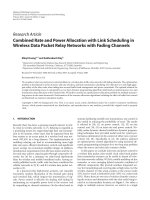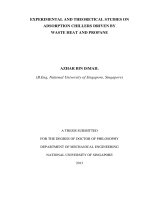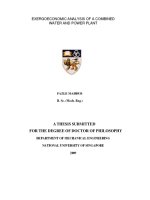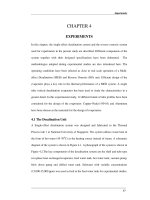Fact Sheet: combined heat and power
Bạn đang xem bản rút gọn của tài liệu. Xem và tải ngay bản đầy đủ của tài liệu tại đây (215.3 KB, 3 trang )
Low Carbon Green Growth Roadmap for Asia and the Pacific
FACT SHEET
Combined heat and power
Key points
•
Combined heat and power can help to improve fuel efficiency by recycling residual heat – which would
otherwise be wasted – from power plants. It is also integral to decentralized energy generation.
•
The application of this technology depends on the policy objective and local context, in light of its
flexibility to accommodate both conventional fossil fuel and renewable energy sources.
Combined heat and power explained
Combined heat and power (CHP, or co-generation) refers to energy systems that concurrently generate electricity and heat from the same fuel source. In conventional power plants, about two thirds of the primary energy
that is converted to produce electricity is lost as waste heat.1
How it works
CHP increases overall energy efficiency by supplying useful heat in addition to electricity. A number of technologies and fuel sources can be used in CHP applications, including renewable biomass. CHP integrates a heat
recovery system to capture waste heat from electricity production and uses the recovered heat to satisfy heating demand of nearby users. CHP applications can be grouped into three categories: industrial, commercial
and district heating and cooling.
CHP facilities can be connected to the electricity grid or stand-alone off-grid systems. Where possible, interconnected CHP facilities can sell excess electricity generation and feed it into the grid. CHP facilities can also function as back-up power production plants.
Opportunities for Asia and the Pacific
Currently, CHP accounts for about 10 per cent of electricity production worldwide, but most of the installed
capacity is in a handful of European countries. Emerging economies, such as many in the Asia-Pacific region,
are particularly lucrative places for CHP development because installing CHP production plants at the same
time as building new industrial facilities reduces the challenge of high overall capital costs. China leads Asia with
CHP plants, contributing 13 per cent of its electricity production, and India follows, at 5 per cent. Both countries
have the potential to produce more than 25 per cent of their total electricity by CHP by 2030.2
Strengths in using combined heat and power
•
Increased energy efficiency: Depending on the technology used, CHP plants operate at 65–80 per cent
efficiency. Producing the same amount of electricity and heat conventionally through separate power
plants and boilers would require about 50 per cent more units of fuel because it operates at around 50
per cent efficiency. On-site electricity production further increases efficiency by eliminating transmission
losses.
1
International Energy Agency, CHP and District Cooling: An Assessment of Market and Policy Potential in India (Paris, IEA and OECD, 2008).
Available from www.iea.org/G8/CHP/docs/IEA_India.pdf (accessed 4 November 2011).
2
International Energy Agency, Cogeneration and District Energy (Paris, IEA and OECD, 2009). Available from
www.iea.org/files/CHPbrochure09.pdf (2 November 2011).
Low Carbon Green Growth Roadmap for Asia and the Pacific : Fact Sheet - Combined heat and power
•
•
•
•
•
Lower energy costs possible: In many cases, fuel savings leads to cost savings. However, the costs of CHP
need to be analysed because it will not lead to cost savings in all cases, especially if the cost of grid
electricity is subsidized or otherwise very low.
Lower emissions: By combusting around two thirds of the fuel used by conventional systems to generate
the same amount of heat and electricity, CHP systems increase eco-efficiency and reduce greenhouse
gas emissions from energy production. And because many CHP plants rely on natural gas, the energy
produced in them has further efficiency gains over the fuel mixes for electricity and heat production in
many countries that rely heavily on coal.
Fuel-switching flexibility: CHP systems can be configured to accept an array of feedstocks, which can
help the system’s users hedge against fuel cost volatility.
Opportunity for development of decentralized energy supply system: Because CHP plants need to be
located near end users of heat generation, the development of such plants encourages the decentralization of the energy supply system, putting the supply plants closer to users.
Important vehicle for promoting energy market diversification: By encouraging the involvement of more
diverse actors in energy production, CHP can be a driver for energy market reform.
Challenges to using combined heat and power
•
•
•
•
•
Capital costs: High capital costs of new CHP plant are a significant hurdle to development in the region.
Geographical limits: Heat can only be transported over very short distances, limiting the use of the heat
generated to areas adjacent to the plant. There is also a limited need for heating in much of the region.
Use of waste heat for cooling requires additional infrastructure.
Infrastructural limits: Pipelines needed to distribute district heating or cooling from CHP plants are under
developed or have limited access in many cities. City planning and investment to make these pipeline
resources more accessible is required.
Operations and maintenance costs: High maintenance costs can cut into cost savings by up to 30 per
cent.
Reliance on thermal energy conversion: Most CHP plants rely on conventional electricity production
technologies. Although they increase the overall system’s efficiency by harnessing waste heat for use,
they do still burn fossil fuels and create greenhouse gas emissions.
Implementing strategies
Install CHP when the existing system needs to be upgraded: To reduce the barrier of high additional capital
costs, CHP systems can be installed when existing boilers or other heating or cooling equipment needs to be
replaced or upgraded.
Use biomass resources, including waste: Because CHP plants need to be distributed and are often placed at
large commercial or medium-sized industrial facilities, using co-firing or biomass-powered plants could be a
viable option and help the facilities manage their wastes.
Sell the emissions reductions: Avoidance of greenhouse gas emissions can qualify CHP facilities for national or
international incentives, such as the certified emissions reductions (CERs) through the Clean Development
Mechanism. Sale of CERs can provide an additional revenue stream.
Optimize CHP in solar thermal and geothermal development: Developers of renewable thermal energy technologies should be cognizant of increased efficiency of CHP when heating or cooling demand centres are
nearby.
Low Carbon Green Growth Roadmap for Asia and the Pacific : Fact Sheet - Combined heat and power
BOX 1: Cutting-edge heating and cooling with dramatic savings in the Republic of Korea
Under the district heating and cooling (DHC) system, apartment buildings, business buildings and commercial
buildings no longer need to install heating and cooling generation systems individually. Instead, co-generation
and heat generation facilities equipped with cutting-edge pollution prevention equipment economically generate energy and supply it to a multitude of users. This advanced urban infrastructure offers the benefits of
energy savings and pollution reduction when compared with existing energy generation methods. Recognizing
these benefits, the Korean Government by end 2008 had provided district heating service to 1.7 million households (about 12 per cent of all households). The Government’s rigorous measures for DHC distribution (20012008) resulted in 23 per cent average annual energy saving, mitigation of 40 per cent of average annual CO2
emissions and waste energy recovery of about 13 per cent from the total energy production. Aiming to reduce
peak energy loads in the summer, the Korean Government announced its plan to provide subsidies of 2 billion
KRW in 2011 for district cooling installations, which are expected to contain 12 MW of maximum electricity
demand and contribute an annual energy saving of 1,565 tons of coal equivalent. An energy welfare
programme was introduced providing subsidies for heating bills for low-income families.
Source: Korea District Heating Corp., The Third Basic Plan for Integrated Energy Supply (Seoul, Ministry of Knowledge Economy, Republic of
Korea, 2009). Available from www.kdhc.co.kr (accessed 3 March 2012).
Further reading
Cogeneration and District Energy (Paris, IEA and OECD, 2009). Available from
www.iea.org/files/CHPbrochure09.pdf
Cogeneration and Renewable Energy (Paris, IEA and OECD, 2011).









